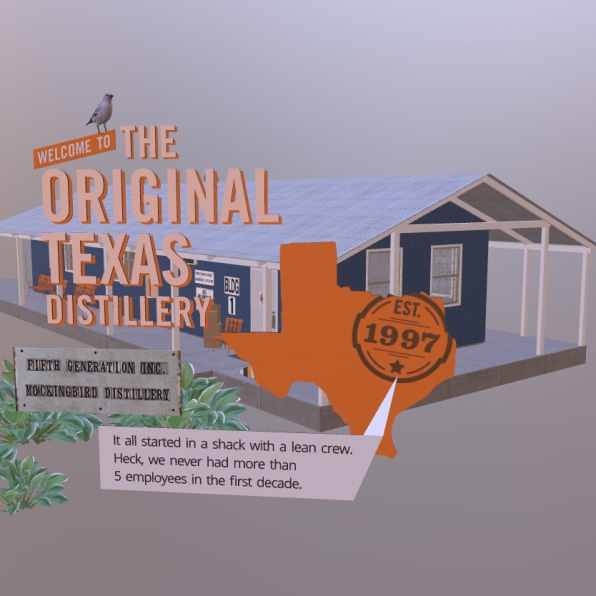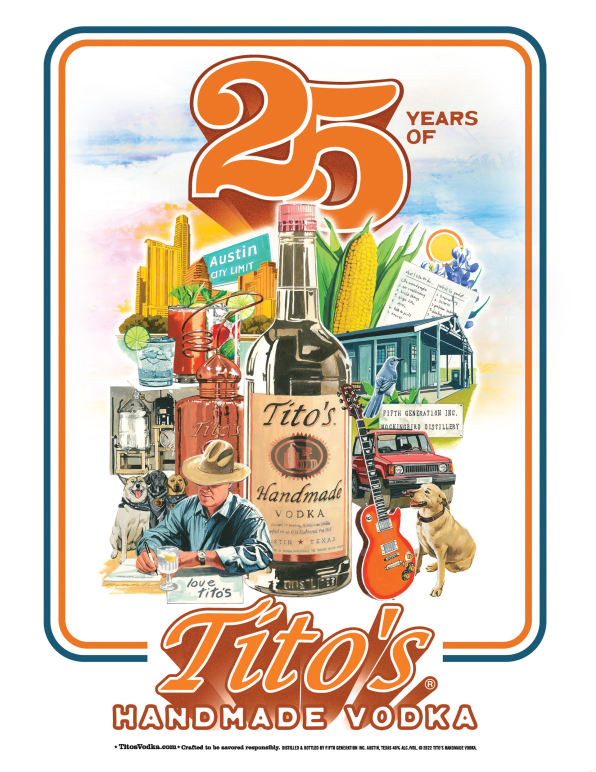Tito’s vodka blends hi-tech and heritage for its 25th anniversary
Founded in 1997 by Bert “Tito” Beveridge in a 1,000 square foot shack in rural Austin, over the last quarter-century Tito’s has grown into one of the country’s most well-known vodkas—complete with a distinctive and approachable all-American brand identity. This year, Tito’s celebrates its 25th anniversary with a campaign that blends its central Texan-rooted heritage with immersive hi-tech—along with a standalone virtual reality (VR) experience set to launch later this season.
In stores this spring, Tito’s debuted a commemorative 25th anniversary bottle, topped with its signature copper cap and wrapped in a new iteration of its familiar label—emblazoned with a special anniversary emblem. Alongside, the vodka company deployed an augmented reality (AR) experience, inspired by retro movie posters and illustrated with specially-commissioned work by artist Paul Mann. Customers who scan a QR code on in-store displays are served 3D pop-up interactive vignettes showcasing elements from Tito’s brand history in four chapters: “The Distillery,” “The Juice,” “The Hometown,” and “The Dogs.”

“Thinking back to some of the original stories about how this company started—Tito’s whole journey of, just, consistent failures, one after another, until ultimate success—it could be a Hollywood movie script,” Taylor Berry, vice president of brand marketing at Tito’s, tells Fast Company of developing the movie poster concept and working in collaboration with Mann, whose work includes Flash Gordon film art and the book cover for Quentin Tarantino‘s Once Upon a Time in Hollywood. “Once we developed the movie poster, there was a sense that a lot of the things that are represented are things that we hold dear at Tito’s—though I think, to an average consumer, it’s a little bit of insider baseball.”
By layering in an optional AR element, consumers have the option to engage more deeply with brand history, directly on their smartphones, at their leisure.
“I think the last thing we ever wanted to do was jump onto a tech trend just because it’s a tech trend. It’s got to have a purpose for our brand in order for us to do it,” Berry says. “We wanted to make sure it wasn’t anything you have to download—it could just pop up on your phone and be a web-based experience.”
For Tito’s fans craving an even more immersive brand experience, the company will launch a standalone VR app for the Meta Quest 2 (formerly known as the Oculus) later this summer. Developed in partnership with creative agency 14Four, and narrated by Tito himself, the app takes players back to 1997, where they will be able to explore the original shack, meet Tito’s dogs, and experience a virtual day in the life at the distillery—including hand-bottling, labeling, and finding all the different infusions crafted in Tito’s early days.
“Our distillery is not made for visitors—it’s very industrial, and as much as I would love to have a tasting room, we just don’t,” Berry says. To create an experiential space, the company opened a Tito’s flagship brick-and-mortar store in Austin in March 2020—but had to temporarily shut for several months during the Covid-19 pandemic. “The year before, during South by Southwest, we took a meeting with a digital creative agency, and we stayed in contact with them for a long time—once the store closed, we started taking the idea [of a VR app] a lot more seriously. Events were canceled, so all of a sudden, we had some opportunistic budget we could work with.”
Building a standalone VR app from scratch took years—”We took a lot of time to really dial in on what the script was going to be, what every one of the different rooms looked like, and what the experience was going to be—and how you’re going to travel through the world, taking into account the audience might be people who are accustomed to using a VR device,” Berry says.

In a crowded landscape, where brands continually seek consumer touch points in an increasingly virtual market, VR, AR, and metaverse activations may seem like they’re just the latest party trick—but two years of social distancing, remote work, and the dilution of city centers has inevitably thrust both customers and marketers into a mixed reality universe.
“If this was two years ago, it might feel out of place, but I think at this point in time, given what we’re trying to accomplish, it’s meant to be a surprise-and-delight type of thing—it’s not going to be the main attraction, and I think it will be fun for any consumer that is associated with the brand,” Berry says. “The goal of both [AR and VR] is to let people experience what has made this brand what it is. A lot of people don’t even think we’ve been around for 25 years, right? Or that it was all started by a guy named Tito Beveridge.”
Fast Company , Read Full Story
(64)


